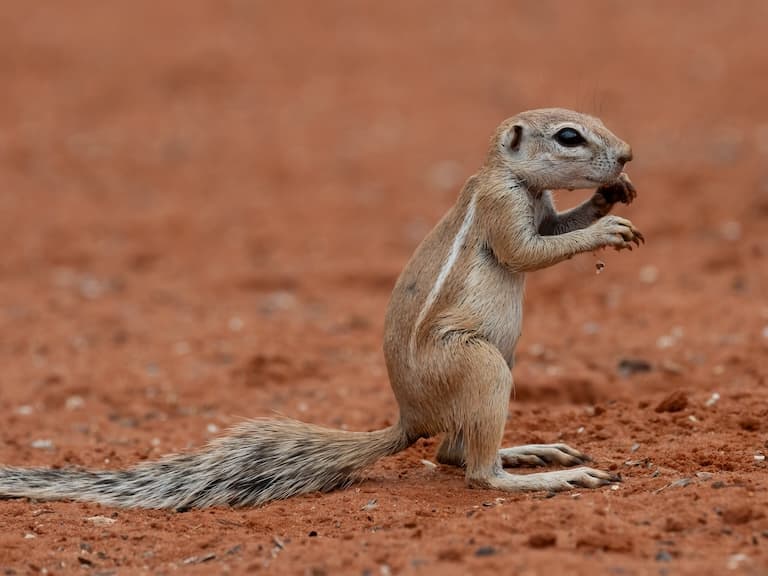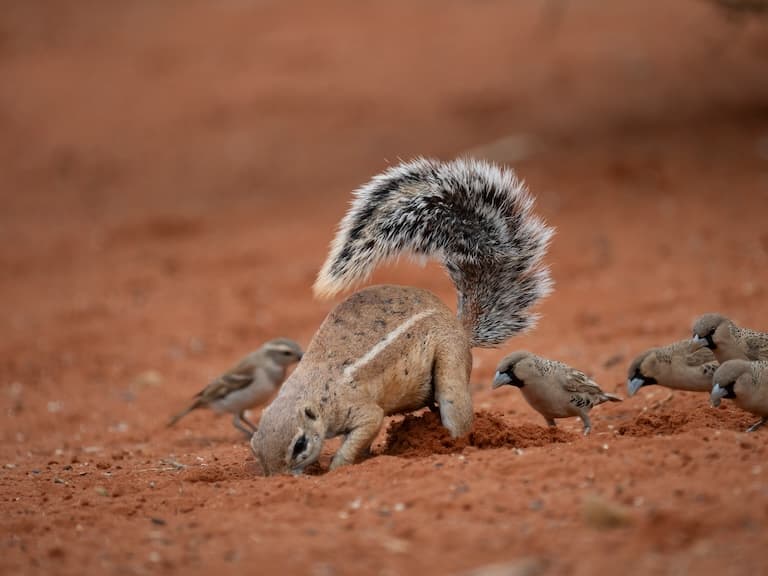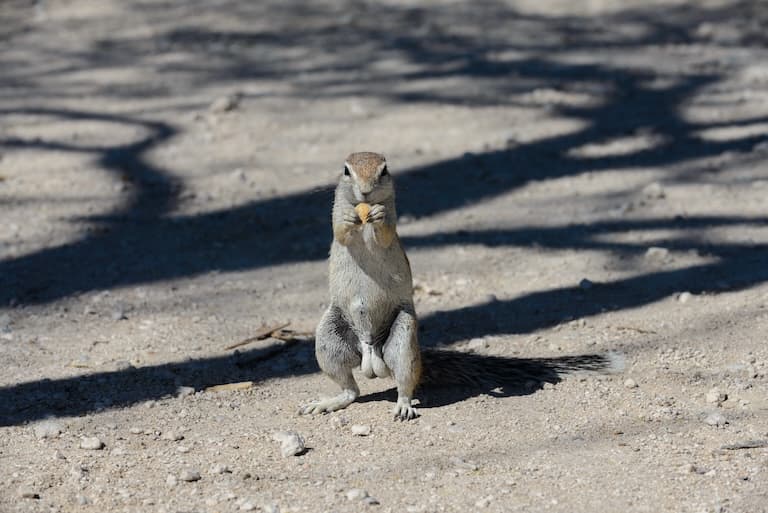Xerus Profile
When a bunch of species gets shuffled around taxonomically, there can be a crystallisation in the understanding of how they all relate to one another and their ecosystems. Unfortunately, since the internet isn’t self-updating, the opposite can happen, too. And for one quite clever little ground squirrel this is exactly what’s going on.
The Xerus genus is one with plenty of outdated and false information attributed to it, and in this profile we’re hoping to change that! Because this unassuming little rodent deserves better.

Xerus Facts Overview
| Habitat: | Arid, open with a little cover |
| Location: | Eastern Africa |
| Lifespan: | Up to around 10 years |
| Size: | |
| Weight: | Up to 420 grams (14.82 oz). |
| Colour: | Brown |
| Diet: | Roots, seeds, fruits, pods, grains, insects, small vertebrates and bird eggs |
| Predators: | Raptors, leopards, jackals, possibly snakes |
| Top Speed: | Not listed |
| No. of Species: | 1 |
| Conservation Status: | Least Concerned |
The Xerus genus of ground squirrels has had its taxonomy updated, but in many respectable realms of the internet, this hasn’t been reflected yet.
The winner of this reshuffling is the unstriped ground squirrel, a clever little African species that puts its larger, dumber ground squirrel contemporaries to shame.
This tenacious, East African species is thriving, despite being considered a significant crop pest in some of the drier regions of Kenya.
Interesting Xerus Facts
1. There can be only one
This is about as gripping as taxonomy ever gets, so strap in:
The Xerus genus (not to be confused with the Xenus genus of warrior princesses (and that one sandpiper)) was once home to a band of squirrels who all lived quite happily within it.
There was the striped ground squirrel, Xerus erythropus, the South African ground squirrel, X. inauris, the Mountain ground squirrel, X. princeps and the one they couldn’t think of a good name for, so just called it the “unstriped ground squirrel”, X. rutilis.
This was a widespread and proud genus for Sub-Saharan Africa since the mid 1900s, until a pesky little researcher and hedgehog expert from Slovenia came along in 2015 and messed it all up. Boris Kryštufek and his team used modern genetic analyses, as well as measurements of their skulls and teeth, to figure out that these squirrels weren’t all that related at all, didn’t overlap in habitats and were in fact worthy of their own genera.
And this is how the runt of the litter, the unimaginatively named, unstriped ground squirrel, Xerus rutilis became the leading (and only) member of the Xerus genus. And the good news is they’re all still in the same tribe: Xerini 1. For now…

2. They’re pretty sharp
Of the three old members of this genus tested in 1981, the unstriped ground squirrel came out ahead in terms of brain size to bodyweight. So, as the brainiest of the bunch it’s only right that it got to keep the name of the genus, but from the population of ground squirrels available this isn’t such a valuable accolade.
Ground squirrels are notoriously “less sharp” than their arboreal counterparts. Marmots, for example, have about the same brain size as the arboreal black giant squirrel, despite the marmots being over four times the mass.
But interestingly, the unstriped ground squirrel ranked even higher than many arboreal counterparts, including the Eastern Gay squirrel with a brain mass of around 1.8% that of its body.
This superior level of intelligence might explain why they’re not so easily worked into a frenzy around immigration as other squirrels2.
3. The males are mostly docile
This species is not considered to be territorial. They do have a dominance hierarchy to maintain order, but they’re not all that fussed about who comes and goes, or where they’re from.
In fact, they’ll even let squirrels from other species in without any argument, including their counterparts the African striped ground squirrels, whom you’d think they’d be the most envious of, but in reality get absolutely no hate whatsoever.
They also let non-residents of their own species use their burrows, and the docility of the males in these diplomatic acts actually results in greater success with the females and more reproductive success overall3.

4. They’re seed specialists
These squirrels like seeds so much that for a long time, that’s almost all people thought they ate. But on closer inspection, they will also branch out into more exotic foods, such as roots, fruit and insects.
Still, more than half of their diet comes from seeds and leaves, particularly the seeds of aloe. Like humans, they appear to be mostly unaffected by tannins, which might give them some defense against predation from other mammals, but they can come into conflict with humans on account of their preference for grains4.
5. They’re a bit of a pest
This diplomatic little squirrel species really only has one enemy, and that’s humans. Farmers in some locations consider them a crop pest, and this is a fair point, only that the farmers have entered the territory of the squirrel and planted crops there, so it’s really just asking for trouble.
This rivalry for grains always ends up with the non-human component losing out, but as of the most recent assessments, this hasn’t even made a dent in their populations.
6. They’re stable
Data on this species is woefully out of date, but as of 2016, the unstriped ground squirrel had a stable population and was of Least Concern on the ICUN Red List.
It’s also noted that the species thrives in multiple protected areas such as national parks and has a wide tolerance to habitat disturbance.
All in all, it’s looking likely that the champion of the Xerus genus is doing very well at representing its tribe!

Xerus Fact-File Summary
Scientific Classification
| Kingdom: | Animalia |
| Phylum: | Chordata |
| Class: | Mammalia |
| Order: | Rodentia |
| Family: | Sciuridae |
| Genus: | Xerus |
| Species Name: | rutilus |
Fact Sources & References
- Kryštufek, et al (2015), “A review of bristly ground squirrels Xerini and a generic revision in the African genus Xerus”, Publication.
- J. Zool., Lond (1981), “Brain size and ecology in small mammals”, Sci hub.
- Warrington, et, al (Year), “Lovers, not fighters: docility influences reproductive fitness, but not survival, in male Cape ground squirrels, Xerus inauris”, Springer Nature Link.
- Isabel Martinez-Welgan (2024), “Xerus rutilusunstriped ground squirrel”, Animal Diversity Web.
